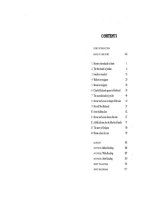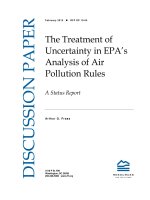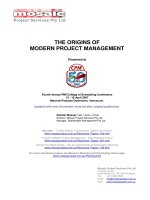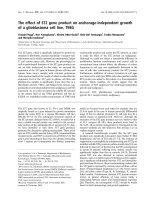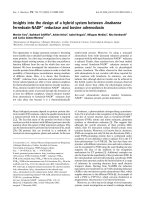The difference of solvent polarity to qualitative and quantitative Phytochemical contents and antioxidant activity of Ficus Roxburghii wall. leaves and fruits extracts
Bạn đang xem bản rút gọn của tài liệu. Xem và tải ngay bản đầy đủ của tài liệu tại đây (383.57 KB, 18 trang )
Int.J.Curr.Microbiol.App.Sci (2019) 8(4): 1724-1741
International Journal of Current Microbiology and Applied Sciences
ISSN: 2319-7706 Volume 8 Number 04 (2019)
Journal homepage:
Original Research Article
/>
The Difference of Solvent Polarity to Qualitative and Quantitative
Phytochemical Contents and Antioxidant Activity of Ficus roxburghii Wall.
Leaves and Fruits Extracts
Pushpa Ruwali* and Sarita Pateliya
Department of Biotechnology, M. B. Government, P.G. College Haldwani-263139,
Uttarakhand, India
*Corresponding author
ABSTRACT
Keywords
Ficus roxburghii,
Extracts,
antioxidant,
Phytochemical,
dose-dependent
Article Info
Accepted:
15 March 2019
Available Online:
10 April 2019
The aim of this work was to establish the antioxidant capacity and the polyphenolic profile
of important medicinal plant, Ficus roxburghii Wall. that could potentially be used in the
human and animal diet. The widespread use of herbal remedies and healthcare preparations
is described in the Vedas and the Bible. Medicinal Plants have been used for thousands of
years to flavor and conserve food, to treat health disorders and to prevent diseases
including epidemics. Active compounds produced during secondary metabolism are
usually responsible for the biological properties of plant species used throughout the globe
for various purposes, including treatment of infectious diseases. One such medicinally
important plant Ficus roxburghii was chosen and the present study was designed to
perform preliminary phytochemical analysis of various extracts of Ficus roxburghii leaves
and fruits viz. methanolic (FRME), ethanolic (FRETH), chloroform (FRCHLO), hexane
(FRHEX). In addition, total phenolic (TPC) and flavonoid (TFC) contents of various
extracts were measured, also the various extracts were evaluated for the antioxidant
capacities using most widely accepted in vitro chemical tests such as DPPH and ABTS
free radical scavenging assays. The result of the preliminary phytochemical analysis
revealed the presence of various phytochemical groups viz. carbohydrates, reducing sugar,
tannins, phenolics, flavonoids, lignins, amino acids, saponins, glycosides, sterols,
triterpenes, and alkaloids with variations among the various extracts. Results for the assays
of antioxidative activity showed that all extracts exhibited significant antioxidant activities
in a dose-dependent manner. The best antioxidant potential was found in Methanolic
extract of F. roxburghii (FRME). FRME has the ability of scavenging ABTS and DPPH
radicals in dose-dependent manner, to much better extent than FRCHLO, FRHEX and
FRETH. This study shows that the fruit and leaf extract of Ficus roxburghii could be used
as a probable antioxidative agent. The leaves of Ficus roxburghii show a more positive
result in the antioxidant and phytochemical test as compared to fruits. Additional highly
developed research is essential for isolation and identification of specific active
components which are responsible for pharmacological properties of the plant.
1724
Int.J.Curr.Microbiol.App.Sci (2019) 8(4): 1724-1741
Introduction
Plants have been used for a variety of
purposes since time immemorial. The history
of humans clearly depicts the use of plants to
treat various diseases; these plants which
possess the healing properties are regarded as
‗medicinal plants‘ or ‗herbs‘. Medicinal
plants are distributed throughout the globe
and India is quite rich in this aspect being one
of the major raw material producing nations
of South East Asia with the Himalayas
supporting a large number of such species.
Also, Uttarakhand possesses an invaluable
treasure of medicinal plants holding a major
share in cultivation and export (Chatterjee et
al., 2014; Tandon, 1996).
The medicinal value of these plants lies in
some chemical substances that produce a
definite physiological action on the human
body. The most important of these bioactive
compounds are alkaloids, flavonoids, tannins,
and phenolic compounds. Herbal medicines
use these different phytoconstituents for
prevention of health issues. These compounds
have also provided us with valuable drugs
such as analgesics (morphine), antitussives
(codeine), antihypertensives (reserpine),
cardiotonics
(digoxin),
antineoplastics
(vinblastine and taxol) and antimalarials
(quinine and artemisinin) (Ramawat et al.,
2009).
Not only in India but the herbal drugs derived
from medicinal plants are also being
prescribed in Germany and France. The
demand for herbal based products has steeply
increased in the European Union with steady
growth in the years reaching to more than 20
billion from about 6 billion in the early 1990s
(Kamboj, 2000). Along with being effective,
these medicinal products are comparatively
cheaper. Medicinal plant drug discovery
continues to provide new and important leads
against various pharmacological targets
including deadly diseases such as cancer,
malaria,
cardiovascular
diseases
and
neurological disorders (Ramawat et al.,
2009).
A free radical is an atom or a molecule that
has an unpaired valence electron and is
capable of independent existence (Halliwell
and Gutteridge, 1999). Radicals are constantly
generated in a living system and being highly
chemically reactive they damage the
biomolecules and tissues leading to various
disease conditions especially degenerative
disease and extensive lysis. Antioxidants are
compounds that prevent the making of free
radicals by inhibiting the process of oxidation.
As a result antioxidants such as thiols,
ascorbic acid and polyphenols are considered
as reducing agents (Sies, 1997). It has been
proven in the past few decades that a diet rich
in antioxidants such as vitamin C, E or
flavonoids, tannins, phenolics, and terpenoids
can prevent oxidative stress and specific
human diseases (Perumalla et al., 2011).
Ficus roxburghii (Timal)
Ficus roxburghii Wall. commonly known as
‗Timal‘ in Hindi and ‗Elephant ear fig‘ in
English is a medicinal plant belonging to the
family of Moraceae (Khan, 2001). The genus
Ficus consists of about 800 species in 40
genera of this family (Adebayo et al., 2009;
Chawla et al., 2012). Ficus roxburghii is one
of the widely distributed species of genus
Ficus and is native to India, Pakistan, China,
Bhutan,
Malaysia,
Myanmar,
Nepal,
Thailand, and Vietnam. It gives pear-shaped
and reddish-brown color fruits, hanging on
peduncles 2.5cm or more (Kala, 2007;
Thinbaijam et al., 2012).
A number of Ficus species are used as food
and for medicinal purposes in ayurvedic and
traditional Chinese medicine to treat several
common ailments as well as its extracts also
1725
Int.J.Curr.Microbiol.App.Sci (2019) 8(4): 1724-1741
contain a wide range of active ingredients
such as phenolic compounds, flavonoids,
alkaloids, sterols, glycosides, saponins, and
carbohydrates and justifying their usage in
food systems. Most of these phytoconstituents
are mainly responsible for strong antioxidant
properties that help in the prevention and
treatment of various oxidative stress-related
diseases such as neurodegenerative and
hepatic diseases (Gaire et al., 2011; Salem et
al., 2013; Achi et al., 2017).
The roasted fruit as well as the juice of this
plant followed by intake of warm saline water
is employed in the treatment of diarrhea and
dysentery (Khan, 2001) also the fruit extract
does contain anti-tumor activity (Aswar et al.,
2008). It is also stated that the gastrointestinal
problems can be treated by using 50-100 ml
fresh juice of leaves with water for about 10
days (Rout et al., 2009).
The use of Ficus roxburghii in the treatment
of diarrhea, dysentery, cuts, wounds, mumps,
cholera, jaundice, etc has been found to be
effective (Gairola and Biswas, 2008). Also,
the latex from the stem is used in treating cuts
and wounds whereas the latex from roots is
used in the treatment of mumps, diarrhea, and
vomiting (Devkota and Karmacharya, 2003).
also it has a blood-boosting effect (Otitoju et
al., 2014; Njoku-oji et al., 2016), anti-sickling
(Umeokoli et al., 2013; Mpiana et al., 2008)
antibacterial (Oyeleke et al., 2008), antiabortifacient (Owolabi et al., 2009), immunestimulatory (Daikwo
et al., 2012),
antidiarrhoea (Owolabi, 2013; Manandhar,
1991), antioxidant (Ramde-Tiendrebeogo et
al., 2012) and pro-fertility in treating
azoospermia (Gelfand et al.,1985; Akomolafe
et al., 2016). Bark and root show
hypoglycaemic and anthelmintic activity
(Mazumder et al., 2009; Ghosh et al., 2004).
Leaves
exhibit
hypotensive
activity
(Buniyamin et al., 2007). The plant is not
only used as a medicine but its fruit is used
for making jams and curries as the ripened
fruit is a good source of nutrients including
minerals, carbohydrates, proteins, and lipids
(Thingbaijam et al., 2012). In some parts of
Himachal Pradesh, the unripe fruit is included
in the diet in the form of vegetable. All the
major parts of the plant including leaves, root,
fruit as well as latex are of great importance
and are a hub of cure to various diseases (Pant
et al., 2009).
Taking into consideration the vast potentiality
of plants as sources for antioxidants, a
systematic investigation was undertaken to
screen the local flora of Kumaun for its
radical scavenging activity so the main aims
of this study were to investigate the effect of
four solvent extracts viz. Methanolic (FRME),
Ethanolic (FRETH), Chloroform (FRCHLO),
Hexane (FRHEX) on phytochemical contents
of Ficus roxburghii leaves and fruits and then
to evaluate their effect on antioxidant
properties by using most widely accepted in
vitro tests such as DPPH and ABTS radical
scavenging activities. In addition, total
phenolic (TPC) and flavonoids (TFC)
contents of various extracts were measured.
The TPC was determined using the FolinCiocalteu method while TFC was determined
using aluminium chloride method.
Materials and Methods
Chemicals
All chemicals, reagents, and solvents were of
the analytical grade obtained from S.D. Fine
Chemical Pvt. Ltd., Mumbai and Hi Media
Laboratories Pvt. Ltd, Mumbai, India.
Collection of plant material
Fresh leaves and fruits of Ficus roxburghii
Wall. specimens were collected from
Haldwani, Nainital district of Uttarakhand
state (India) in the month of February 2018,
1726
Int.J.Curr.Microbiol.App.Sci (2019) 8(4): 1724-1741
strictly abiding by the standard precautions.
The collected plant was identified at the
Department of Botany, DSB Campus,
Kumaun University, Nainital.
Processing of the plant material
The leaves and fruits samples were
thoroughly washed, dried, and ground into
fine homogeneous powder and were kept in
sealed polyethylene bags in a refrigerator at
4°C till further use. The leaves and fruits
samples have been indicated as Ficus
roxburghii leaves (FRL) and Ficus roxburghii
fruits (FRF), respectively.
Extract preparation using various extracts
The powdered leaves and fruits of Ficus
roxburghii Wall. were extracted with different
solvents like methanol, hexane, chloroform,
and ethanol. The herb to solvent ratio was
kept 1:10 to ensure complete extraction.
The plant material was extracted by cold
maceration for 72 hours with the respective
solvent with intermittent agitation. After
incubation, the extracts were filtered through
Whatman@ filter paper (Grade 1) and the
extracts were collected and stored at 4°C in
the refrigerator in an airtight container till
further use (Ahuja et al., 2011).
Preliminary phytochemical screening of
various extracts of Ficus roxburghii Wall
Major
phytochemical
group‘s
viz.,
carbohydrates, reducing sugars, amino acids,
saponins, glycosides, flavonoids, tannins,
sterols, triterpenes, and phenols were traced in
different solvent extracts of FRL and FRF
following standard procedures (Harborne,
1973; Sofowara, 1982; Ruwali et al., 2015).
Quantitative phytochemical analysis of
various extracts of Ficus roxburghii Wall
Total phenolic content
The amount of phenol in the aqueous extract
was determined by the Folin-Ciocalteu
reagent method with some modifications
(Singleton and Rossi, 1965). The calibration
curve was prepared by mixing different
solutions of Gallic acid (1ml; 20-120μg/ml)
with 5 ml of Folin-Ciocalteu reagent (tenfold
diluted) and 4 ml of Na2CO3 (7.5%). The
absorbance of the sample was measured at
765nm. Gallic acid was used as standard
(1mg/ml). All the tests were performed in
triplicates. The results were determined from
the standard curve and were expressed as mg
Gallic acid equivalent (GAE)/gm of the dried
extract.
Total flavonoid content
Percentage yield calculation of various
extracts
The percentage yield of various extracts of
Ficus roxburghii was calculated from the
product that was obtained after complete
evaporation of the respective solvents as per
the following formula (Ruwali et al., 2015).
Where (WE = weight of the plant extract; WS=
Weight of the initial sample)
Flavonoid contents were measured by the
aluminium chloride colorimetric assay
described by (Zhishen et al., 1999) with slight
modifications (Ruwali et al., 2015). For this,
1ml of plant extract or standard solution of
Quercetin (20-120μg/ml) was added to 10 ml
volumetric flask containing 4 ml of TGDW,
followed by addition of 0.3 ml 5% NaNO2.
After 5 min, 0.3 ml of 10% AlCl3 was added.
At 6th min, 2 ml of 1 M NaOH was added and
the total volume was made up to 10 ml with
TGDW. The solution was mixed well and the
1727
Int.J.Curr.Microbiol.App.Sci (2019) 8(4): 1724-1741
absorbance was measured against prepared
reagent blank at 510 nm. TFC was expressed
as mg Quercetin equivalent (QE)/gm of plant
dried extract.
Antioxidant activity of various extracts of
Ficus roxburghii Wall
Analysis of the antioxidant activity of various
extracts of Ficus roxburghii was done by
performing DPPH and ABTS free radical
scavenging assays, as per standard protocols.
the mixture to stand in the dark for 12-16
hours (hrs) before use. The ABTS+ solution
was diluted with ethanol to an absorbance of
0.700 ± 0.05 at 734nm for measurements. The
photometric assay was conducted on 0.9ml of
ABTS+ solution and 0.1 ml of sample extract
of various concentrations and mixed for 45
sec; measurement was taken immediately at
734nm after 15 min.
The scavenging activity was estimated based
on the percentage of ABTS radicals
scavenged by the following formula:
DPPH free radical scavenging assay
The antioxidant activity of the extracts was
measured on the basis of the scavenging
activity of the stable DPPH free radical
according to the method described by (BrandWilliams et al., 1995) with slight
modifications. 1ml of 0.2mM DPPH solution
in methanol was mixed with 1ml of plant
extract solution of varying concentrations (25,
50, 100, 200 and 400μg/ml). The
Corresponding blank sample was prepared
and Quercetin in different concentration was
used as the reference standard. The reaction
was carried out in triplicate and the decrease
in absorbance was measured at 517nm after
30 minutes in dark using UV-Vis
spectrophotometer. The inhibition % was
calculated using the following formula.
Where—‗Ac‘ is the absorbance of the control;
‗As‘ is the absorbance of the sample
ABTS Free Radical Scavenging Assay
For ABTS assay, the procedure followed was
the method of (Re et al., 1999) with slight
modifications. ABTS radical cation (ABTS+)
was obtained by reacting ABTS+ stock
solution with 2.45 mM potassium persulfate
(final concentration) (1/1, v/v) and allowing
Where—‗Ac‘ is absorption of control; ‗As‘ is
absorption of tested extract solution.
Statistical analysis
Statistical analysis was carried out using
Windows Excel 2007.All the experiments
were done in triplicates. The experimental
results are expressed as mean ± SD of triplets.
The half-maximal inhibitory concentration
(IC50) value was calculated using the linear
regression analysis.
Results and Discussion
Plant phytochemicals have been reported to
prolong life by their protections against
numerous human health and metabolic
conditions. Ficus roxburghii Wall. plant,
being a potential source of bioactive
compounds, has the ability to ameliorate
various lifestyle-related diseases. Ficus
species are a rich source of polyphenolic
compounds, flavonoids which are responsible
for strong antioxidant properties that help in
the prevention and treatment of various
oxidative stress-related diseases such as
neurodegenerative and hepatic diseases. In the
present study, leaves and fruit extracts from
Ficus were analysed for their phytochemical
1728
Int.J.Curr.Microbiol.App.Sci (2019) 8(4): 1724-1741
and antioxidant properties. The purpose of
this work was to perform phytochemical
screening and to determine the correlation
between total phenolic contents and
antioxidant activities performed by ABTS
assay and DPPH assay of different solvent
extracts from fruits and leaves of Ficus
roxburghii.
Extraction yield
The yield of crude extracts from the leaves
and fruits of Ficus roxburghii, obtained by
maceration method using different type of
solvents (methanol, ethanol, hexane and
chloroform), and was calculated (Ruwali et
al., 2015). The yields of soluble substances,
expressed as in percentage in leaves and fruits
of Ficus roxburghii are closely dependent on
the solvents, as shown in Figure 1. The
variation in the yields of extracts could be
attributed to the difference in solvent
polarities used which also plays a key role in
increasing the solubility of phytochemical
compounds (Silva et al., 2014; Naima et al.,
2015). Differences in the structure of
phytochemical compounds also determine
their solubility in solvents of different polarity
(Felhi et al., 2016a).
As evident in the Figure 1, the Methanolic
extract of both leaves and fruits gave the
highest yield (15.36%), (14%) respectively,
followed by Chloroform extract (13%),
(11.71%), Hexane extract (11.61%), (9.83%)
and least in Ethanolic extract (10.67%), (8)
respectively. Figure 1 shows that the
percentage yields for leaves and fruits with
methanolic extract were better than other
solvents. In the present study, we also
observed variation in % yield of solvent
extracts of FRL and FRF.
Preliminary phytochemical analysis
Qualitative phytochemical tests were carried
out to identify some bioactive components of
the extracts. Phytochemical screening helps to
reveal the chemical nature of the constituents
of the plant extract. It may also be used to
search for bioactive agents that could be used
in the synthesis of very useful drugs
(Sofowora, 1993; Yakubu et al., 2005).
The phytochemical screening of various parts
(leaves and fruits) of Ficus roxburghii,
showed the great presence of tannins,
flavonoids, saponins, sterols, triterpenes,
glycosides, reducing sugars and alkaloids and
the results observed are depicted in Table 1.
Phytochemicals are biologically active,
naturally occurring chemical compounds
found in plants, which provide health benefits
(Hasler and Blumberg, 1999). In general, the
plant chemicals that protect plant cells from
environmental hazards such as pollution,
stress, drought, UV exposure and pathogenic
attack are called phytochemicals. Recently, it
is clearly known that they have roles in the
protection of human health when their dietary
intake is significant (Mathai, 2000).
The phytochemical screening revealed the
presence of carbohydrates, alkaloids, reducing
sugar, saponins, and flavonoids in all four
solvents viz. methanol, ethanol, hexane, and
chloroform extracts of both leaves and fruits.
Lignin and amino acids were present in
methanol, chloroform and hexane extracts of
both leaves and fruits but were absent in
ethanolic extracts. Tannins were found to be
present in methanolic extracts of both fruits
and leaves. Triterpenes absent in chloroform
extracts of leaves, whereas present in all
extracts of fruits except hexane extracts.
Sterol absent in hexane extracts of both leaves
and fruits, whereas present in all three
extracts. In ethanolic extract of FRL phenolic
compounds are absent and in hexane and
ethanolic extracts of FRF, the phenolic
compounds are also absent. Plant extracts
revealed the presence of phytochemicals such
as phenols, tannins, flavonoids, saponins,
1729
Int.J.Curr.Microbiol.App.Sci (2019) 8(4): 1724-1741
glycosides, steroids, terpenoids, and alkaloids,
which are known to exhibit medicinal as well
as physiological activities.
Flavonoids are referred to as nature‘s
biological response modifiers because of their
inherent ability to modify the body‘s reaction
to allergens, viruses, and carcinogens. They
show
anti-allergic,
anti-inflammatory,
antimicrobial and anticancer activity (Rauha
et al., 2000; Cushnie and Lamb, 2005;
Spencer and Jeremy, 2008). Saponins also
inhibit cancer tumour growth in animals,
particularly, lung and blood cancers, without
killing normal cells. Saponins are the plant‘s
immune system acting as an antibiotic to
protect the plant against microbes and fungus
(Chatterrjee
and
Chakravorty,
1993).
Carbohydrates play a major role in promoting
health fitness, from a major part of a food and
help a great deal in building body strength, by
generating energy (David and Michael, 2006).
Total phenolic contents
Phenolic compound possesses biological
properties such as apoptosis, anti-aging, anticarcinogen,
anti-inflammation,
antiatherosclerosis, cardiovascular protection and
improvement of endothelial function, as well
as inhibition of angiogenesis and cell
proliferation activities. Some phenolic
compounds present in natural products have
higher antioxidant activities than those of
synthetic antioxidants (Ruwali et al., 2017).
Polyphenolics, on reaction with Folin–
Ciocalteu reagent under basic conditions
dissociate to form a phenolate anion, which
reduces molybdate in Folin–Ciocalteu reagent
forming a blue colored molybdenum oxide
with maximum absorption near 765 nm. The
intensity of the blue colored complex is
proportional to the amount of polyphenolic
compounds present in the sample (Huang et
al., 2005).
The total phenolics of various extracts were
assessed and expressed as mg GAE/gm of the
dry weight of the extract. The content of
phenolics varied among different extracting
solvents used. The result of total phenolics of
Ficus roxburghii leaves and fruits in various
extracts are summarized in Figure 2 as (mg
GAE/ gm of the dry weight of the extract).
Methanolic extract has the highest phenolic
content in both leaves and fruits, followed by
Chloroform, followed by Hexane and least in
Ethanolic extract. Thus the TPC of leaves has
high phenolic content as compared to fruits.
Total flavonoid concentration
Flavonoids are the most common group of
plant polyphenols. Different studies have
shown that these compounds are used for the
prevention and cure of many diseases. They
are capable of effectively scavenging the
reactive O2 species because of their phenolic
hydroxyl groups and so they are potent
antioxidants also (Cao et al., 1997). Regular
intake of flavonoids has reduced the risk of
acute as well as a chronic disease like cancer,
cardiovascular disease, and inflammatory
responses.
Flavonoids protect plants against UV damage,
which, to some extent, results from the fact
that they can act as a screen absorbing UV
radiation and, as they are accumulated mainly
in the epidermis and hypodermis of leaves
and stems, apical meristem and pollen,
reducing the penetration of UV light to the
vulnerable tissues or organs. Besides UV
absorption, flavonoid compounds may also
transfer or accept light energy to or from
other molecules via sensitization (Sisa et al.,
2010).
From this (Fig. 3) data, the result of total
flavonoids of Ficus roxburghii leaves and
fruits in the various extracts is summarized.
1730
Int.J.Curr.Microbiol.App.Sci (2019) 8(4): 1724-1741
Methanolic extract has the highest flavonoid
content in both leaf and fruit, followed by
Chloroform, and followed by Hexane and
least in Ethanolic extract. Thus the leaves
have high flavonoid content as compare to
fruits.
In vitro Antioxidant activity of various
extracts of Ficus roxburghii
Antioxidant activity of various extracts of
Ficus roxburghii was assessed by standard
and currently most accepted methods viz.
DPPH stable free radical scavenging assay
and the ABTS radical scavenging assay.
DPPH free radical scavenging activity of
various extracts of Ficus roxburghii.
DPPH is one of the free radicals widely used
for testing preliminary radical scavenging
activity of the plant extract (Bhuiyan et al.,
2009). Antioxidants either transfer an electron
or a hydrogen atom to DPPH, thus
neutralizing its free radical character (Pan et
al., 2008). DPPH test, which is based on the
ability of DPPH, a stable free radical, to
decolorize in the presence of antioxidants, is a
direct and reliable method for determining
radical scavenging action (Hasan et al., 2009).
The reducing capacity of DPPH radical could
serve as an indicator of potential antioxidant
property (Meir et al., 1995). Substances
which are able to perform this reaction can be
considered as antioxidants and therefore
radical scavenges. It was found that the
radical scavenging activities of extract
increased with increasing concentration
(Ruwali et al., 2017).
The antioxidant potential of various
concentrations (µg/ml) of Quercetin as well as
various extracts of Ficus roxburghii is
expressed as percent (%) inhibition and
depicted in the Figure 4 and 5. In case of
Methanolic, Chloroform, Hexane and
Ethanolic extract, 400µg/ml concentration
showed maximum DPPH radical scavenging
activity followed by 200µg/ml, 100µg/ml,
50µg/ml and 25µg/ml show the least activity.
The amount of antioxidant activity present in
leave and fruit solvents are in the order of,
Quercetin > Methanol > Chloroform >
Hexane > Ethanol. These scavenging
activities are most probably and mostly due to
the presence of the various phenolic
compound.
The antioxidant activity of the sample is
evaluated from the determination of IC50
values corresponding to the amount of
extracts required to scavenging 50% of DPPH
radicals present in the reaction mixture.
Lower IC50 values indicate higher radical
scavenging ability (Table 2).
The results of the present study showed that
among various extracts, the lowest IC50 value
was of methanolic extract and highest IC50
value was of ethanolic extract of F.
roxburghii of both the plant parts used (leaf
and fruit). The IC50 value of leaf extracts is
less than the IC50 value of fruit extracts. This
indicates that the leaves of Ficus roxburghii
can be a good source of natural antioxidants.
ABTS free radical scavenging activity of
various extracts of Ficus roxburghii
According to (Silva et al., 2012) the ABTS
assay is based on the generation of
chromophore cationic radical obtained from
the oxidation of ABTS by potassium
persulfate. ABTS radical scavenging method
is a common spectrophotometric procedure
for determining the antioxidant capacities of
plants. The ABTS method is easy to use, has
high sensitivity, and allows for rapid analyses
of the antioxidant activity of a larger number
of samples. In the ABTS test, 2, 2‘-azinobis
1731
Int.J.Curr.Microbiol.App.Sci (2019) 8(4): 1724-1741
(3-ethylbenzthiazoline- 6- sulfonic acid)
(ABTS) is converted into its radical cation
(ABTS+) by addition of sodium per sulphate.
This blue-green radical cation absorbs light at
734 nm. ABTS is reactive towards most
antioxidants. It is not affected by ionic
strength, and it can be used to determine both
hydrophilic and hydrophobic antioxidant
capacities. During this reaction, the bluegreen ABTS radical cation is converted back
into its colourless neutral form (Debnatha et
al., 2011). In case of methanolic, ethanolic,
hexane and chloroform extracts, 400µg/ml
concentration of crude extract show
maximum activity followed by 200µg/ml,
100µg/ml, 50µg/ml and 25µg/ml (Fig. 6 & 7).
The amount of ABTS free radical scavenging
activity in solvents were in the order of,
Ascorbic acid > Methanol > Chloroform >
Hexane > Ethanol. The results are indicative
of that the methanolic, chloroform, hexane,
and ethanolic extracts of leaves and fruits of
Ficus roxburghii are efficient free radical
scavenging. Among the four extracts of both
leaves and fruits tested, methanolic extracts
possessed maximum radical scavenging
activity, followed by chloroform, hexane and
ethanolic extracts respectively. Table 3 shows
the significant decrease in the concentration
of ABTS radical due to the scavenging ability
of the Ficus roxburghii. The results of the
present study showed that among all extracts,
the lowest IC50 value was of methanolic
extract of F. roxburghii leaves and fruits and
highest IC50 value was of ethanolic extract of
F. roxburghii leaves and fruits. The IC50 value
of leaves extracts is less than the IC50 value of
fruits extracts. This indicates that the leaves
of Ficus roxburghii can be a good source of
natural antioxidants. Various solvents having
different polarities were employed for the
extraction of antioxidant components present
in Ficus roxburghii leaves and Fruits. Our
study confirms the difference in the extraction
efficiency of the various solvents, which
suggests that the solvent effect should be
taken into account while addressing the
antioxidant potential of any sample. From this
study, a suggestion regarding the use of
methanol for the extraction can be made, if
Ficus roxburghii leaves and fruits are to be
used as functional food or medicine.
Table.1 Preliminary phytochemical tests for various solvent extracts of F. roxburghii (FRL/FRF)
Phyto chemicals
Group
Carbohydrates
Reducing sugar
Tannins
Phenolic
Flavonoids
Lignin
Amino acid
Saponins
Glycosides
Sterols
Triterpenes
Alkaloids
FRL
FRME
+
+
+
+
+
+
+
+
+
+
+
+
FRCHLO
+
+
+
+
+
+
+
+
+
+
FRHEX
+
+
+
+
+
+
+
+
FRETH
+
+
+
+
+
+
+
FRF
FRME
+
+
+
+
+
+
+
+
+
+
+
FRCHLO
+
+
+
+
+
+
+
+
+
FRHEX
+
+
+
+
+
+
+
+
+Indicates the presence; −indicates the absence, FRL: Ficus roxburghii Leaves, FRF: Ficus roxburghii Fruits,
FRME: Methanolic extract, FRCHLO: Chloroform extract, FRHEX: Hexane extract, FRETH: Ethanolic extract
1732
FRETH
+
+
+
+
+
+
+
Int.J.Curr.Microbiol.App.Sci (2019) 8(4): 1724-1741
Table.2 IC50 of various solvent extracts (DPPH assay)
Sample
IC50 value(µg/ml)FRL
IC50 value (µg/ml)FRF
Methanol
Chloroform
Hexane
Ethanol
Ascorbic acid
112.74±1.35
120.33±0.26
128.96±1.02
271.14±0.32
111.62±0.53
181.55±0.46
224.17±0.67
225.06±1.74
278.2±0.23
156.41±0.58
Table.3 IC50 value of various solvent extracts (ABTS assay)
Sample
IC50 Value (µg/ml) FRL
IC50 Value (µg/ml) FRF
Methanol
Chloroform
Hexane
Ethanol
Ascorbic acid
115.23±0.71
118.72±1.41
122.24±1.52
189.76±0.89
114.5±0.47
151.32±0.14
152.17±2.12
210.92±0.98
217.51±2.02
149.18±1.01
Fig.1 Percentage yield of various solvent extracts of Ficus roxburghii (FRL/FRF)
18
% yield of plant extract
16
14
12
10
8
FRL
6
FRF
4
2
0
Methanol
Chloroform
Hexane
Ethanol
Plant extracts in different solvent
1733
Int.J.Curr.Microbiol.App.Sci (2019) 8(4): 1724-1741
Fig.2 Total phenolic content of various extracts of Ficus roxburghii (FRL/FRF). values
expressed are mean±standard deviation (n=3)
Fig.3 Total flavonoid content of Ficus roxburghii (FRL/FRF). values expressed are
mean±standard deviation (n=3)
1734
Int.J.Curr.Microbiol.App.Sci (2019) 8(4): 1724-1741
Fig.4 DPPH free radical scavenging activity of various extracts of FRL and Ascorbic acid.
values expressed are mean±standard deviation (n=3)
Fig.5 DPPH free radical scavenging activity of various extracts of FRF and Ascorbic acid. values
expressed are mean±standard deviation (n=3)
1735
Int.J.Curr.Microbiol.App.Sci (2019) 8(4): 1724-1741
Fig.6 ABTS free radical scavenging activity of various extracts of FRL and Ascorbic acid.
values expressed are mean±standard deviation (n=3)
Fig.7 ABTS free radical scavenging activity of various extracts of FRF and Ascorbic acid values
expressed are mean±standard deviation (n=3)
The evaluation of antioxidant competency of
Ficus roxburghii leaves, Fruits by means of
different assays recommends the use of this
plant as nutraceuticals. The results indicated
that the different part of Ficus roxburghii
Wall. could be a potential natural source of
antioxidants and may have greater importance
as a natural antioxidant able to slow down or
prevent oxidative stress especially leaves
extracts.
In conclusion, the present research work
concludes that Ficus roxburghii is an
important medicinal plant with varied
1736
Int.J.Curr.Microbiol.App.Sci (2019) 8(4): 1724-1741
pharmacological
spectrum.
Qualitative
phytochemical analysis of plant parts extracts
is important as it indicates the nature of
phytochemicals that are possessed by such
medicinal plant. The results showed that the
solvent used in extraction affects the yield,
total phenolic, total flavonoid, contents and
their antioxidant properties in various
degrees.
The
highest
contents
of
phytochemical contents were obtained with
methanol extracts. The estimation of phenolic
and flavonoid content resulted in the highest
content in the methanolic extract of leaves
and fruits. From different methods of
evaluating antioxidant activity, it was
concluded that methanol, chloroform, ethanol,
and hexane extract showed activity but
methanol showed the most significant one of
all extracts we can say that methanol is better
solvent compared to other solvents. The in
vitro antioxidant activities of the plant
extracts indicate that they could be used to
prevent oxidative stress and associated
disorders. From all these results we can
conclude that the leaves of Ficus roxburghii
can be a good source of natural antioxidants
in comparison to fruits. Further studies are
needed for the isolation and identification of
bioactive
compounds
responsible
for
antioxidant activity. The antioxidant activities
of pure compounds could then be validated in
vivo before clinical use.
Acknowledgement
We extend our gratitude to the Department of
Biotechnology, MBGPG College Haldwani
(Kumaun University), for their consistent
encouragement throughout the research work.
Author’s contribution
PR designed the study and wrote the
manuscript. SP and PR performed the
experiments. PR analyzed and verified the
data.
Conflict of interest: The authors declare no
conflict of interest.
References
Achi, N.K., C. Onyeabo, Ekeleme-Egedigwe,
C.A. and Onyeanula, J.C. 2017.
Phytochemical, Proximate analysis,
vitamin and mineral composition of
aqueous extract of Ficus capensis
leaves in South Eastern Nigeria. J.
Appl. Pharm. Sci. 7(3): 117-122.
Adebayo, E.A., O.R. Ishola, O.S. Taiwo and
Majolagbe, O.N. 2009. Evaluations of
the Methanolic extract of Ficus leaf,
root and stem for phytochemical
analysis. Afri. J. Plant Sci. 3(12): 283287.
Ahuja, J., Suresh, J., Deep, A, Madhuri,
Pratyusha,
and
Ravi.
2011.
Phytochemical screening of Aerial part
of Artemisia parviflora Roxb: A
medicinal plant. Der pharmacia Lettre.
3(6):116-124.
Akomolafe, S.F., G. Oboh, Oyeleye, S.I. and
Boligon, A.A. 2016. Aqueous extract
from Ficus capensis leaves inhibits key
enzymes linked to erectile dysfunction
and prevent oxidative stress in rats'
penile tissue. NFS Journal. 4:15-21.
Aswar, M., U. Aswar, B. Watkar, M. Vyas
and Wagh, A. 2008. Anthelmintic
activity of Ficus. Int. Green Pharma.
2(3): 170-172.
Bhuiyan, M.A.R., M.Z. Hoque and Hossain,
S.J. 2009. Free Radical Scavenging
Activities of Zizyphus mauritiana.
World J. Agr. Sci. 5: 318-322.
Brand-Williams, W., M.E. Cuvelier and
Berset, C. 1995. Use of a free radical
method to evaluate antioxidant activity.
Lebensmittel Wissenschaft Technol, 28:
25-30.
Buniyamin, A., E.I. Ayinde, O. Fabain and
Amaechina, C. 2007. Pharmacognosy
and hypotensive evaluation of Ficus
1737
Int.J.Curr.Microbiol.App.Sci (2019) 8(4): 1724-1741
(Moraceae) leaf. Acta Polo. Pharma.
64(116): 543-546.
Cao, G., E. Sofic and Prior, R.L. 1997.
Antioxidant and pro-oxidative behavior
of flavonoids, structure activity
relationships. Free Radical. Biol. Med.
22: 749-760.
Chatterjee, S., A. Banerjee, and Chandra, I.
2014. Hemidesmus indicus: A Rich
Source of Herbal Medicine. Med. Aro.
Plants. 3: e155.
Chatterjee, S., Banerjee, A. and Chandra, I.
2014. Hemidesmus indicus: A Rich
Source of herbal Medicine. Med
Aromat
Plants.
3:
e155.doi:
10.4172/21670412.1000e155.
Chatterjee, T.K. and Chakravorty, A. 1993.
Wound healing properties of new
antibiotic (MT81) in mice. J. Bioch.
Pharmacol. 30: 450-452.
Chawla, A., R. Kaur and Sharma, A.K. 2012.
Ficus:
A
Review
on
its
Pharmacognostic, Phytochemical and
Pharmaceutical Aspects. Int. J. Pharm.
Phytopharm. Res. 1(4): 215-232.
Cushnie, T.P. and Lamb, A.J. 2005.
Antimicrobial activity of flavonoids.
Int. J. Antimicrob. Agents. 26(5): 343356.
David, L. and Michael, M. 2006. Freeman
and Company. N Y. Principles
Biochem, 45: 118-122.
Debnatha, T., P.J. Park, N.C.D. Nath, N.B.
Samad, H.W. Park, and Lim, B.O. 2011.
Antioxidant activity of Gardenia
jasminoides Ellis fruit extracts. Food
chem. 128: 697-703.
Devkota, R. and Karmacharya, S.B. 2003.
Documentation
of
indigenous
knowledge of Meidicinal plants in
Gwalek, Baitadi, Nepal. Botanica
Orientalis 3:135-143.
Felhi, S., Baccouch, N., Ben Salah, H.,
Smaoui, S., Allouche, N., Gharsallah,
N. and Kadri, A. 2016a. Nutritional
constituents, phytochemical profiles, in
vitro antioxidant and antimicrobial
properties, and gas chromatographymass spectrometry analysis of various
solvent extracts from grape seeds (Vitis
vinifera L.). Food Sci. Biotechnol.
25(6): 1537-1544.
Gaire, B.P., Lamichhanr, R., Sunar, C.B.,
Shilpakar, A., Neupane, S., and Panta,
S. 2011. Phytochemical screening and
analysis of antibacterial and antioxidant
activity of Ficus roxburghii stem Bark.
J. Pharmacogn. 3(21): 49-55.
Gairola, Y. and Biswas, S. 2008.
Bioprospecting in Garhwal Himalaya,
Uttarakhand. Curr. Sci. 94: 1139-1144.
Gelfand, M., Mavi, S., Drummond, R.B. and
Ndemera, B. 1985. The traditional
medicinal practitioner in Zimbabwe.
Mambo Press, Gweru, Zimbabwe.
1985; 411.
Ghosh, R., Kh. Sharathchandra, Rita, S. and
Thokchom, I.S. 2004. Hypoglycaemic
activity of Ficus hispida (bark) in
normal and diabetic albino rats. Indian
Journal of Pharmacology. 36(4): 222225
Halliwell, B. and Gutteridge, J. 1999. JMC,
Free Radicals in Biology and Medicine,
Clarendon Press, Oxford. J. Med. Plant
Res. 8(2): 676-683.
Harborne, J.B. 1973. The flavonoids:
Advances in Research. Chapman and
Hall, London. J. Sci. Food Agri. 3(75):
90-103.
Hasan, R.S.M., M.D. Mokarram Hossain, A.
Raushanara, M.D. Mariam Ehsanul
Hoque Mazumder, and Shafiqur
Rahman. 2009. DPPH free radical
scavenging activity of some Bangladesh
medicinal plants. J. Med. Plant Res.
3(11): 875-879.
Huang, X., K.A. Yuasa, T. Norikura, D.O.
Kennedy, T. Hasuma, and Yuasa, M.I.
2005. Mechanism of the anticancer
activity of Zizyphus jujube in HepG2
cells. Int. J. compl. Med. East and West,
1738
Int.J.Curr.Microbiol.App.Sci (2019) 8(4): 1724-1741
35(3): 517-532.
Kala, C.P., 2007. Prioritization of cultivated
and wild edibles by local people in the
Uttarakhand hill of Indian Himalaya.
Indian J. trad. Know. 6:239-244.
Kamboj, V.P., 2000. Herbal medicine. Curr.
Sci. 78(1): 35-39.
Khan, S., 2001. Therapeutic plants of the
Ayurveda: a review of selected clinical
and other studies for 166 species. J.
Alter. Compl. Med. 7(5): 405-515.
Manadhar, N.P., 1991. Medicinal plant-lore
of Tamang tribe of Kavrepalanchok
district, Nepal. Econ. Bot. (2): 45-58.
Mathai, K., 2000. Nutrition in the Adult
Years. In Krause‘s Food, Nutrition, and
Diet Therapy,.L.K. Mahan and S.
Escott-Stump, 27: 271-274.
Mazumder, P.M., M. Farswan and Parcha, V.
2009. Hypoglycaemic effect of Ficus
arnottiana Miq. Bark extracts on
streptozocin induced diabetes in rats.
Nat. Prod. Rad. 8(5): 478-482.
Meir, S., Kanner, J., B. Akiri and Hada, S.P.
1995. Determination and involvement
of aqueous reducing compounds in
oxidative defense system of various
senescing leaf. J. Agri. Food chem. 43:
1813-1819.
Miller, N.J., C. Rice-Evans and Paganga, G.
1997. Antioxidant properties determind
by ABTS radical assy. Free radical res.
26: 195-199.
Mpiana, P.T., Mudogo, V., Tshibangu,
D.S.T., Kitwa, E.K., Kanangila, A.B.,
Lumbu, J.B.S., Ngbolua, K.N., Atibu
EK, Kakule MK. 2008. Antisickling
activity of anthocyanins from Bombax
pentadrum, Ficus capensis, Zizyphus
mucronata: Photo degradation effect. J.
Ethnopharmacol. 120: 413-418.
Naima, R., M. Dumam, H. Hannache, A.
Sesbou, B. Charrier, Pizzi, A. and
Charrier-El Bouhtoury, F. 2015.
Comparison of the impact of different
extraction methods on polyphenols
yields and tannins extracted from
Moroccan Acacia mollissima barks. Ind.
Crops Prod. 70: 245-252.
Njoku-Oji, N.N., C.V. Nwike, U. Dimkpa,
N.O. Ifegwu, L.C. Anike, S.O. Maduka,
Sobanke, O.A. and Uchefuna, R.C.
2016. Hematological changes following
oral administration of aqueous leaf
extract of Ficus capensis in albino rats.
Int. Blood Res. Reviews. 5(1): 1-7.
Otitoju, G.T.O., Nwamarah, J.U., Otitoju, O.,
and Iyeghe, L.U. 2014. Nutrient
composition of some lesser known
green leafy vegetables in Nsukka L.G.A
of Enugu State. J Biodivers Environ Sci.
4(4):233-239
Owolabi, O.J., Z.A. Nworgu, A. Falodun,
Ayinde, B.A. and Nwako, C.N. 2009.
Evaluation of tocolytic activity of
ethanol extract of the Stem bark of
Ficus capensis Thunb. (Moraceae).
Acta Pol. Pharm. 66(3):293-296.
Oyeleke, S.B., Dauda, B.E.N. and Boye, O.A.
2008. Antibacterial activity of Ficus
capensis.
Afri.
J.
Biotechnol.
7(10):1414-1417.
Pan, Y., K. Wang, S.Q. Huang, H.S. Wang,
X.M. Mu, C.H. He, X.W. Ji, J. Zhang
and Huang, F.J. 2008. Antioxidant
activity of microwave-assisted extract
of longan. (Dimocarpus Longan Lour.)
peel. Food Chem. 106(3): 1264-1270.
Pant, S., S.S. Samant and Arya, S.C. 2009.
Diversity and indigenous household
remedies of the inhabitants surrounding
Mornaula reserve forest in West
Himalaya. Indian J. Tradit. Know. 8(4):
606-610.
Perumalla, A.V.S., Hettiarachchy, N.S. and
Ricke, S.C. 2011. Current perspectives
in poultry preharvest food safty. In
Direct fed microbials/prebiotics for
animals: science and mechanisms of
action. Ethnopharmacol. 78(7): 89-120.
Ramawat, K.G., Dass, S. and Mathur, M.
2009. The Chemical Diversity of
1739
Int.J.Curr.Microbiol.App.Sci (2019) 8(4): 1724-1741
Bioactive Molecules and Therapeutic
Potential of Medicinal Plants. Herbal
Drugs: Ethnomed. Modern Med,
Springer- Verlag Berlin Heidelbergs.
Ramde-Tiendrebeogo, A., A. Tibiri, A. Hilou,
O.M.
Lomp,
H.
Millogo-Kone,
Nacoulma, O.G. and Guissou, I.P. 2012.
Antioxidative
and
antibacterial
activities of phenolic compounds from
Ficus sur Forssk. and Ficus sycomorus
L. (Moraceae): Potential for sickle cell
disease treatment in Burkina Faso. Int.
J. Biol. Chem. Sci. 6(1):328-336
Rauha, J. Remes, S. and Heinonen, M. 2002.
Antimicrobial effects of Finnish plant
extracts containing flavonoids and other
phenolic compounds. Indus. J. Food
Microbiol. 56: 3-12.
Re, Raina, A.K. and Perry, 1999. Antioxidant
properties determind by ABTS radical
assay. Free radical Res. 26: 195-199.
Rout, S.D., Panda, T. and Mishra, N. 2009.
Ethnomedicinal plants used to cure
different diseases by tribal‘s of
Mayurbhanj district of North Orissa.
Ethno-Med. 3(1): 27.
Ruwali, P., Ambwani, T.K. and Gautam, P.
2017. In vitro antioxidative potential of
Artemisia indica willd. Indian J. Animal
Sci. 87(11): 1326-1331.
Ruwali, P., Ambwani, T.K., Gautam, P. and
Thapliyal, A. 2015. Qualitative and
quantitative phytochemical analysis of
Artemisia indica Willd. J. Chem. Parm.
Res. 7: 942-949.
Salem, M.Z.M., Salem, A.Z.M., Camacho,
L.M. and Ali, H.M. 2013. Antimicrobial
activities
and
phytochemical
composition of extracts of Ficus
species: An over view. Afr. J.
Microbiol. Res. 7(33): 4207-4219.
Sies, H. 1997. Oxidative stress: Oxidants and
antioxidants. Exp-Physiol. 82(2): 291295.
Silva, C.P.D., M.S.B. Sousa, E.S. Siguemoto,
Soares, R.A.M. and Areas, J.A.G. 2014.
Chemical composition and antioxidant
activity
of
jatoba-do-cerrado
(Hymenaea stigonocarpa Mart.) flour.
J. Food Sci. Technol. 34(3): 597-603.
Silva, R.A., Lima, M.S.F., Viana, J.B.M.,
Bezerra, V.S., Pimentel, M.C.B., Porto,
A.L.F., Cavalcante, M.T.H. and Lima
Filho, J.L. 2012. Can Artisanal
‗‗Coalho‘‘ Cheese from Northeastern
Brazil Be Used as a Functional Food.
Food Chem. 135: 1533-1538.
Singleton, V.L. and Rossi, JA. Jr. 1965.
Colorimetry of total phenolics with
phosphomolybdic – Phosphotungstic
and ragent. Amer. J. Enol. Vitical, 16:
144-158.
Sisa, M., Bonnet, S.L., Ferreira, D. and van
der
Westhuizen,
J.
H.
2010.
Photochemistry
of
flavonoids.
Molecules. 15: 5196-5245.
Sofowara, A. 1982. Medicinal plants and
traditional medicinal in Africa. New
York: John Wiley and Sons. J. Biol. Sci.
41: 154-176.
Spencer and Jeremy, P.E. 2008. ―Flavonoids:
modulators of brain function?‖. Br. J.
Nut.
99:
ES60–7.
Doi:10.1017/S0007114508965776.
Tandon, V. (1996). Med. Plant Conserv.
Newsl, 2: 12-13.
Thingbaijam, R., Dutta, B.K. and Paul, S.B.
2012. In vitro antioxidant capacity,
estimation of total phenolic and
flavonoid content of Ficus roxburghii.
Int. J. Pharm. Pharm. Sci. 4(4): 518521.
Thingbaijam, R., Dutta, B.K. and Satya, B.P.
2013.
Antihyperglycemic
and
Antihyperlipidemic activity of Ficus
roxburghii.
Leaf
Extract
in
Streptozotocin Induced Diabetic Mice.
World J. Pharm. Pharm. Sci. 3 (1): 412427.
Umeokoli, B.O., F.A. Onyegbule, Gugu, T.H.
and Igboeme, S.O. 2013. Evaluation of
the erythropoietic and anti-sickling
1740
Int.J.Curr.Microbiol.App.Sci (2019) 8(4): 1724-1741
properties of Ficus capensis leaf extract
in the treatment of anaemia. Planta
Medica. 79 -PE29.
Yakubu, M.T., Akanji, M.A. and Oladiji, A.T.
2005. Aphrodisiac potentials of the
aqueous extract of Fadogia agrestis
(Schweinf. Ex Hiern) stem in male
albino rats. Asian J. Androl. 7(4): 399404.
Zhishen, J., Mengcheng, T. and Jianming, W.
1999. The determination of flavonoid
contents in mulberry and their
scavenging effects on superoxide
radicals. Food chem. (65): 555-559.
How to cite this article:
Pushpa Ruwali and Sarita Pateliya. 2019. The Difference of Solvent Polarity to Qualitative and
Quantitative Phytochemical Contents and Antioxidant Activity of Ficus roxburghii Wall.
Leaves and Fruits Extracts. Int.J.Curr.Microbiol.App.Sci. 8(04): 1724-1741.
doi: />
1741
